研究成果
Partial Elucidation of the Salt Excretion Mechanism in the Super Crop "Quinoa"
―Paving the Way for Developing Salt-Tolerant Crops―
June 25, 2025
|
Main Points
|
Overview
JIRCAS, in collaboration with Nagoya University, RIKEN, and Kyoto University, has revealed part of the mechanism behind the high salt tolerance of the super crop quinoa, which has remained largely unexplained for many years.
Originating from the Andes in South America, quinoa is not only highly nutritious but can also be cultivated in extreme environments. This makes it a promising food source in the face of worsening environmental conditions due to climate change. Recognizing its potential, the Food and Agriculture Organization (FAO) of the United Nations designated 2013 as the “International Year of Quinoa,” highlighting its importance in addressing global food and nutrition challenges.
Moreover, due to its nutritional value, NASA has considered quinoa a suitable food for astronauts, and in recent years, it has gained worldwide popularity as a superfood.
This study aimed to uncover why quinoa thrives in harsh conditions by investigating its salt tolerance mechanisms. It was found that quinoa seedlings can continue to grow without hindrance in sodium chloride (NaCl) concentrations as high as 600 mM—equivalent to seawater—conditions that would be lethal to most plants.
The research also revealed that sodium accumulation in the aerial parts differs by regional lineage. Notably, the southern highland varieties grown in the high-salinity soils near the Uyuni Salt Flats in Bolivia absorbed less salt into their aerial parts than varieties from other regions. This suggests they may have evolved mechanisms to limit salt uptake above ground.
Furthermore, three sodium transporters were identified as functioning in quinoa’s salt excretion process. These findings open the door to utilizing quinoa’s mechanisms for breeding or engineering crops resistant to salt damage.
This research is expected to contribute to global food security, improved nutrition, and the achievement of SDG Goal 2: Zero Hunger.
This research was published in the international scientific journal Frontiers in Plant Science on June 18, 2025 (Japan time) as an open-access article.
Related Information
This research was supported by:
- SATREPS Program (JST-JICA joint initiative): “Strengthening of Resilience in Arid Agro-Ecosystems Vulnerable to Climate Change, Through Research on Plant Resources and Technological Applications” (PI: FUJITA Yasunari, Project No. JPMJSA1907)
- Moonshot R&D Program by BRAIN: “Achieving Zero Food Risks by Improving Crop Robustness Using Cyber-Physical Systems” (PI: FUJITA Yasunari, Project No. JPJ009237)
- Grants-in-Aid for Scientific Research (KAKENHI): Project No. JP22K05374, JP23KK0113, JP21H02158, JP23K18036, JP23K05192, JP24K08839, JP24H00499, JP25H00935
- Operational Expenses Grant Project: “Development of Resilient Crops and Production Technologies”
Publication
- Authors
- KOBAYASHI Yasufumi, SUGITA Ryohei (Nagoya University), FUJITA Miki (RIKEN), YASUI Yasuo (Kyoto University), MURATA Yoshinori, OGATA Takuya, NAGATOSHI Yukari, FUJITA Yasunari
- Paper Title
- CqHKT1 and CqSOS1 mediate genotype-dependent Na+ exclusion under high salinity conditions in quinoa
- Journal Title
- Frontiers in Plant Science
DOI: https://doi.org/10.3389/fpls.2025.1597647
For Inquiries
For Inquiries: KOYAMA Osamu
- Program Director:
- FUJITA Yasunari
- Research Staff:
- KOBAYASHI Yasufumi (Biological Resources and Post-harvest Division)
- Press Coordinator:
- OMORI Keisuke (Head, Information and Public Relations Office)
Emai: koho-jircas@ml.affrc.go.jp

